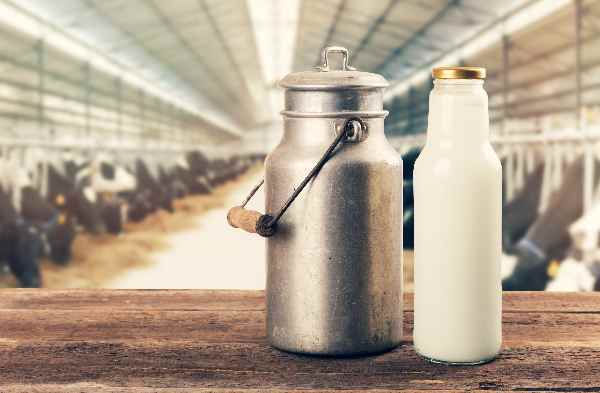Milk and acne - myth or fact?
In recent years there’s been a lot of discussion about how dairy products such as milk can upset or even instigate an episode of acne, but despite the numerous studies and pages of research, the link between the two still remains vague.
However, in a world where it’s rapidly becoming trendy to completely cut out certain food groups, dairy is on the elimination list for many, especially sufferers of adult acne. Is this really the right approach though, and is milk really that bad for your skin?
Is milk really the perfect food for acne?

In 2011, a study concluded that milk is nature’s ‘perfect food for acne1', finding that there was a correlation between the consumption of milk and the development of acne, however, it’s important to note that the direct cause of this relationship could not be identified.
There’s no denying though, that milk is definitely a risk for your skin. It’s estimated that around 75% of the world suffer from some degree of lactose intolerance2 so right away that’s an immediate red flag, however you also have to look at what is in milk to get a better idea about how it can affect your skin and trigger an outbreak of acne.
Milk contains approximately 60 different hormones and this makes sense when you think about it. Often farmers feed their livestock a cocktail of antibiotics, not to mention the grass that cows eat is often loaded with pesticides. Then you have to consider the idea that cow’s milk is made specifically for growing calves, so it has high levels of IGF-1.
IGF-1 is a growth hormone that may increase your production of sebum oil, which as you may be aware, can be a major cause of adult acne. One study found that 1-2 servings of milk a day managed to raise IGF-1 levels by 16% compared to those that drank milk infrequently.3
You also have to consider that milk can promote inflammation and can even interact with the testosterone in your body, stimulating a breakout! So it’s no wonder really that milk has such a poor reputation when it comes to the health of your skin.
1http://www.menshealth.com/health/does-dairy-cause-acne
2https://authoritynutrition.com/is-dairy-bad-or-good/
3https://academic.oup.com/jnci/article/93/17/1330/2519487/Milk-Intake-Circulating-Levels-of-Insulin-Like
What about other dairy products?

Okay, so milk might not be the best food for your skin but what about other dairy products such as cheese or yoghurts? Well there’s varying information on these fronts and a variety of different factors that you may have to consider.
Firstly, let’s take a look at yoghurt. On one hand, most yoghurts you probably buy from your supermarket are loaded with sugar, which can affect your insulin levels and increase the bio-availability of IGF-1. On the other hand though, the probiotics that are contained in sugar-free yoghurts can help to reduce inflammation and the fermentation process reduces the content of IGF-1.4 Good news!
Ice cream is a big no-no though – not only does it contain milk, it’s also loaded with sugar so I wouldn’t overdo it on Ben & Jerry’s if you suffer from acne. Cheese is a difficult dairy to pinpoint – hard cheeses do contain lower levels of sugar but there’s no evidence to support whether they help or hinder acne.
So when it comes to dairy, you really have to take a good look at what’s in the product. If it’s overloaded with sugar, then the chances are that it’s not going to help your breakout and may even make it worse!
4http://www.menshealth.com/health/does-dairy-cause-acne
Should I just cut out all dairy products?

As I mentioned earlier, going dairy-free is becoming an increasingly popular option, but it’s not one you should just leap into on a whim. Milk may contain a barrage of hormones, but it’s also rich in protein and calcium, vital nutrients that your body needs to survive.
If you do want to know whether dairy is responsible for your acne, I would start by eliminating dairy products from your diet for four weeks, just to see if you notice a difference. However, this can be difficult to achieve, so I would start by cutting out milk.
It’s important to note that semi-skimmed milk can be more harmful than full fat. This is because semi-skimmed milk usually contains additional proteins such as whey and casein, which can release similar hormones to IGF-1!
If you are looking for a milk substitute, you have to be aware of your allergens and your needs, especially when it comes to protein. You should also be aware that non-dairy milks can still upset your symptoms. Soya milk, for example, is considered to be a major allergen and many nut milks contain high amount of added sugar so make sure you do your research first! Check out our guide to dairy-free milk for more information!
Once you have replaced milk with an appropriate substitute, wait and see if you notice any differences. If you do see that your skin is starting to clear up, then you’ve identified what the problem was. However, if you notice no changes, consider other sources of dairy in your diet – are you still munching on chocolate or enjoying the odd scoop of ice cream?
If this is still the case, then you may need to expand to include all dairy products, but this is not an option I’d take likely so it might be a good idea to speak to your doctor first!





 Looking for our products in a store near you?
Looking for our products in a store near you?

